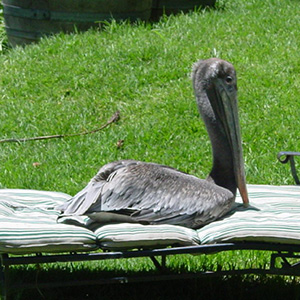

Judy Irving, the Bay Area-based director of The Wild Parrots of Telegraph Hill, continues her observations of the bird kingdom in Pelican Dreams. She follows the rehabilitation of a 3- to 4-month-old pelican rescued after it wandered into traffic on the Golden Gate bridge. Irving names it “GG,” for the bridge. Monte Merrick, the wild animal rescuer who nurses this pelican, doesn’t believe in names for wild animals, and calls it “P193.” By Merrick’s lights, you don’t even initiate eye contact with the pelicans, though he talks to the birds in his care: “You should eat!”
Despite the warning, Irving’s camera peers into the pelican’s eyes and the anthropomorphizing continues; the pelicans start to look wry, smart and pleased with themselves. “When I love something, I tend to think I know all about it,” Irving says, so she tries to learn more. They’ve been on earth for 30 million years. They’re only 8-10 pounds despite their size. Their blood is 103 degrees, yet they are birds who thrive in very cold water. Pelicans can live 40 years, but they’re tied to a not very wide margin of land and water, and they have just one rookery in the US—Santa Barbara Island. Irving travels by boat to watch the birds among the cactus of the Channel island.
During mating season, the pelican’s eyes turn blue and their throats turn crimson. Having no voices, the pelicans communicate through gestures—from tantrumy fits when very hungry, to twirling to catch the attention of a potential mate. Pelican Dreams reaches highest aw-factor in a silent sequence at the home of the bird-rescuing Dani and Bill Nicholson of Cayucos, California; their permanent guest, “Morro,” silently paces into their living room, puzzling over the furniture.
The pelicans survived a plummet because of DDT in the 1960s—not agricultural runoff but the result of the Montrose Chemical Company spilling waste into the LA storm drains. Today, the pelicans face new troubles: “What are we releasing birds into?,” a naturalist worries, considering depleted fisheries, climate change, and the stress that’s causing pelicans to kill and devour other sea birds. Without prettying up their future, Irving celebrates them now. The foggy seascapes are rapturous. A wealth of feeling is the hallmark of Irving’s documentaries: feeling, self-questioning, a clarity of intention that reminds one of Agnes Varda.
Pelican Dreams
Not rated
Opens Fri.



